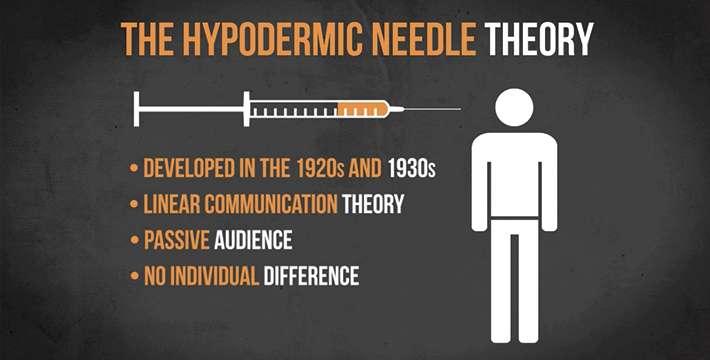The Hypodermic Needle Theory
Today, we’re talking about the Hypodermic Needle Theory which was one of the earliest ways of thinking about how the mass media influences audiences. It was developed in the 1920s and 1930s after researchers observed the effect of propaganda during World War I and events like Orson Welles’ War of the Worlds broadcast. The Hypodermic Needle Theory is a linear communication theory which suggests that media messages are injected directly into the brains of a passive audience. It suggests that we’re all the same and we all respond to media messages in the same way.
This way of thinking about communication and media influence is no longer really accepted. In the 1930s, many researchers realized the limitations of this idea and some dispute whether early media theorists gave the idea any serious attention at all. Nevertheless, The Hypodermic Needle Theory continues to influence the way we talk about the media. People believe that the mass media has a powerful effect. Parents worry about the influence of television and violent video games. News outlets run headlines like ‘Is Google making us stupid’ and ‘Grand Theft Auto led teen to kill’.
So how did this way of thinking about the mass media develop? Back in 1927, Harold Lasswell – an American political scientist and communication theorist – published a book called Propaganda Technique in the World War. Writing about the effect of Allied propaganda during World War I, Lasswell wrote: “From a propaganda point of view it was a matchless performance, for Wilson brewed the subtle poison, which industrious men injected into the veins of a staggering people, until the smashing powers of the Allied armies knocked them into submission.”
The Payne Fund Studies, which were conducted between 1929-1932 and looked at the effect movies have on children, also contributed to this idea that the mass media has a powerful and direct influence on audiences. Although these studies have been criticised for their lack of scientific rigor, they were really one of the first and most comprehensive examinations of how the media works. Writing about the influence of movies, the project chairman WW Charters wrote that they have the potential to profoundly affect the way children behave. Even in the 1930s, however, researchers were starting to realise that this way of thinking about media influence was kind of inadequate.
Then, in 1938, Orson Welles and the Mercury Theatre broadcast a dramatization of HG Wells’ War of the Worlds. The program, which was presented in the format of a news bulletin, caused some listeners to believe that Earth was being invaded by martians. The New York Times claimed that thousands of people were gripped by mass hysteria. While thousands of people may have been “panic-stricken”, they were only a small proportion of the six million people who enjoyed a quiet night around the radio.
On the surface, events like these seem to suggest that the media can have a powerful influence on audiences. Nevertheless, The Hypodermic Needle Theory is kind of inadequate to describe communication and media influence. It just doesn’t work.
Further reading
University of Twente: Hypodermic Needle Theory
Wikipedia: The Hypodermic Needle Model
Audience Theory: An Introduction
